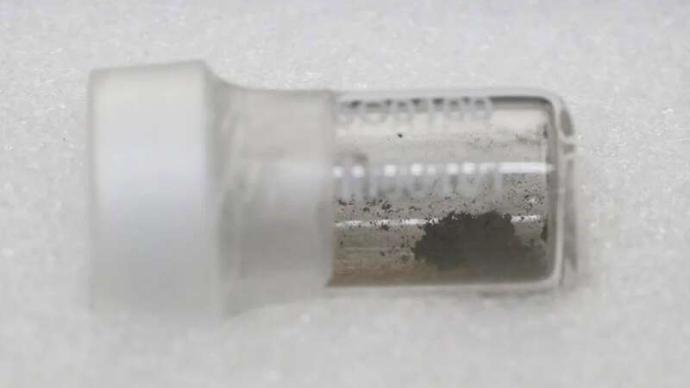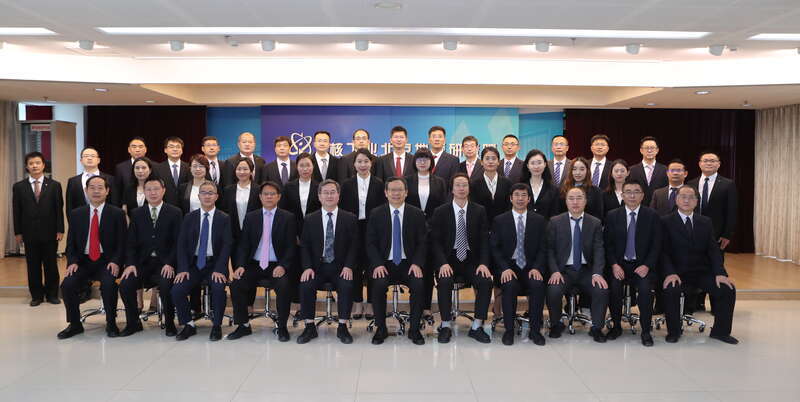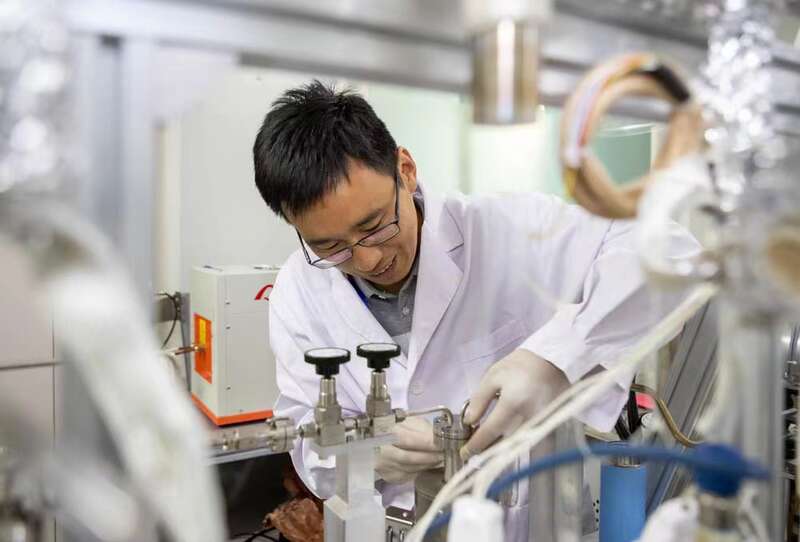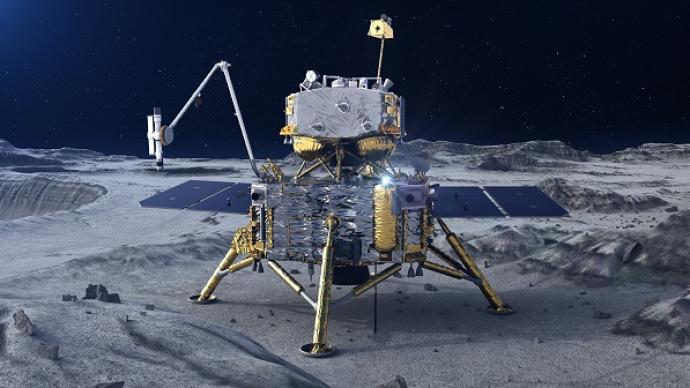
On September 9, at No. 8 Fucheng Road in Beijing (where the National Space Administration and the National Atomic Energy Agency are located), it was announced to the outside world that Chinese scientists discovered a new mineral on the moon for the first time, named "Chang'e Stone".
Another day is the Mid-Autumn Festival. After the news was released, it attracted attention, and many netizens called it "Mid-Autumn Festival gifts from the moon".
This is also the sixth lunar new mineral discovered internationally.
Its discovery changed the history of lunar mineral exploration in my country, making my country the third country in the world to discover new lunar minerals.
Today, Li Ziying, the 58-year-old leader of the lunar research team of the Beijing Institute of Geology of the Nuclear Industry of China National Nuclear Corporation (hereinafter referred to as the Institute of Geology), could not hide his excitement at the press conference. He led the team after more than a year of hard work. , discovered this new lunar mineral.

The true face of the lunar sample Lushan Mountain. Photo courtesy of China National Space Administration, China Atomic Energy Agency, and China National Nuclear Corporation
Open, a world of "rice"
The night was already dark.
Sitting at the table, staring at the microscope, using a slender nano-sampling needle, repeatedly tried to peel off a particle less than 0.000001 mg... This action has been going on for more than two hours. Ting's body was stiff and her eyes were sore. But she didn't want to give up, this "little thing" that might disappear under the microscope was too precious.
What she calls "little things" is the Chang'e 5 lunar soil sample.
On December 17, 2020, Chang'e 5 returned to Earth with 1,731 grams of lunar samples. The application of lunar samples is extremely competitive. A total of 85 applications from 23 universities and research institutes passed the preliminary review. After on-site defense, only 31 applications from 13 units passed the review, with a pass rate of only 36.5%.
On July 12, 2021, the first batch of 50 mg of lunar soil arrived at the Institute of Earth Research.
Huang Zhixin still remembers this day, the person in charge of the first batch of lunar samples at the Earth Research Institute told reporters, "Of the 50 mg, the agreement we signed stipulates that only 20 mg can be lost."
What is the concept of 20 mg?
"It's probably a bigger grain of rice." Even Li Ting, who is used to working under a laboratory microscope, said frankly: "Moon soil is extremely precious, and even such tiny particles cannot be wasted in vain."

Microscope photo of a lunar sample. Photo courtesy of China National Space Administration, China Atomic Energy Agency, and China National Nuclear Corporation
The process of dividing samples is the "most exciting and stressful" part of the research on Yueyang, and it is no exaggeration to say that it uses "excited heart" to stabilize "shaking hands".
The sample division is carried out in the ultra-clean room. Two people enter the operation together, and they need to wear special lab coats and gloves. The whole process is monitored by cameras. Before opening the samples, the team made an experimental plan, including sampling steps, the amount of samples taken out, how many parts are divided, how much each part is, how to divide and transfer for different experiments, and so on.
In this lunar soil research, Li Ting is responsible for the need to select and classify thousands of tiny particles according to the experimental design. "The scale used for the aliquots is a million scale, which can be accurate to 0.001 mg. The most difficult thing is to weigh several 0.1 mg samples - a mung bean is about 80 mg, which is equivalent to they need to take 1/800 of a mung bean, A little shake of the hand is too much." Li Ting said.
She told reporters that such a small number of samples must be weighed as accurately as possible at one time. Every time I weigh it, I first evaluate it by eye, staring at the almost invisible "black dots" in the sampling spoon, weighing it again and again, and estimating that it can't be too much before I dare to pour it into the sample tank. Each empty sample well is weighed three times, and the sample is placed three times again to ensure accurate weighing.
"Usually when we select earth samples, we can smear Vaseline and other viscous substances on the needle to help 'dip' the samples, and then safely transfer them to other places. The selection of lunar soil does not allow the introduction of foreign 'contamination', The sample can only be adsorbed by a little static electricity generated by the friction between the needle tip and the particles. Often the needle tip pushes the sample back and forth on the glass sheet, but it cannot be retrieved. Every time this time, it is both desperate and collapsed.” Li Ting said.
I can only take a deep breath, stabilize my broken emotions and stiff shoulders, and try again and again. Among these particles, the small ones are less than 1/100 of the diameter of a hair, and the large ones are about the thickness of a hair.
After repeated failures again and again, after "deadly fighting" with this batch of samples for more than two months, the "little things" were finally captured by the fine tip of the glass wire in Li Ting's hand - the sampling of new minerals was successful!

Scanning electron microscope photos of Chang'e stone and symbiotic minerals. Photo courtesy of China National Space Administration, China Atomic Energy Agency, and China National Nuclear Corporation
Repeated operations gave Li Ting a particularly deep understanding of the lunar soil samples. Faced with the large amount of data obtained from the analysis of this batch of samples, the careful girl made a major discovery: "There is a calcium-containing phosphate mineral, which contains The amount of rare earth elements is much higher than we have ever known in this type of mineral structure, which means that this is a new mineral beyond our knowledge."
However, where is it? The mineral was too small and too small to find a good particle in this batch of samples that would allow the team to decipher its structure.
Decipher, 1 in 140,000 chance
On a Saturday in the middle of winter in 2021, the entire office building was empty.
"Quiet and gasping sounds are clearly audible." Zhong Jun still remembers the 8 hours he spent carefully in the laboratory. It was at that moment that his lunar team at the Institute of Geosciences successfully isolated a micron-sized mineral, laying the foundation for their new discovery.
The scanning electron microscope repeatedly confirms and accurately locates the minerals to be separated and cut. The high-energy focused ion beam cuts obliquely from the surrounding of the minerals, and the bottom is obliquely "into the knife" to separate the target minerals from the surrounding rocks. A tungsten needle thinner than a human hair is inserted. After shaping the tungsten needle with a focused ion beam, it is welded to the separated target minerals with platinum vapor. The collected target minerals are taken out from the instrument cabin and stored in a special sample. The "capsule", which takes it to the laboratory where crystal structure analysis is carried out next...
Through systematic research on the first batch of lunar soil scientific samples, the team found traces of the new mineral and determined the chemical composition of the mineral. However, because the particles of the new mineral were too small and too few, the ideal crystal structure parameters of the new mineral could not be obtained. It is necessary to further search for qualified large-particle specimens with the help of new lunar soil samples before it is possible to fully confirm.
As a "successor", Zhong Jun focused on the research theme of nuclear energy uranium thorium fission elements, and repeatedly considered and selected the most suitable lunar samples to be applied for. He has read a lot of literature, discussed repeatedly with team members, and constantly optimized and improved the borrowing application and reporting materials.
In the end, their material stood out from more than 240 applications and was successfully borrowed into 1 lunar light sheet sample.

Group photo of the lunar sample research team. Photo courtesy of China National Nuclear Corporation Nuclear and Earth Research Institute
Zhong Jun recalled that as soon as the light sheet was obtained, the scientific research team immediately used the in-situ micro-area test and analysis method to carry out mineral-scale research. First, a quick surface scan was performed on all minerals in the entire sample. Among the crumb particles, several rare earth-rich phosphate mineral particles, which are only one-tenth the diameter of a human hair, were successfully “grabbed”.
"In order to verify the existence of new minerals, we need to cut these particles out and accurately interpret the crystal structure of the single crystal of the mineral. The relatively large and pure components are suitable for our potential targets for deconstruction. There are only three minerals, which are extremely small and rare." Zhong Jun said.
In the end, the only particle that could be used for subsequent verification was identified.
The mineral research team led by Li Ting used a single crystal X-ray diffractometer to carry out the follow-up fine structure interpretation of the potential new mineral, and confirmed the new mineral.
This isn't the first new mineral the Institute has discovered in its geological analysis. In the past three years, Li Ting's team has led and participated in the discovery of 5 new earth minerals.
Tracing the source, the infinite curiosity behind scientific exploration
What made them grab that 1 in 140,000 chance?
Diligence, unity, attentiveness, focus... There are 22 members of the team, each of whom has his own answer, but when all these answers come together, it is precisely the phrase "opportunities are reserved for those who are prepared".
In November 2020, under the leadership of Li Ziying, the lunar research team of the Earth Research Institute, after numerous research discussions, decided to focus on lunar nuclear fission and fusion elements as the main research direction. Subsequently, the Earth Research Institute established a lunar sample analysis and testing laboratory.
"Improve the application management and use system for lunar samples, build a clean room for lunar sample storage and processing, and simulate sample drills. These three tasks have been prepared together from that moment." Guo Dongfa, director of the Institute of Analysis and Testing, said.
In fact, the acquisition of any major scientific research results cannot come from cramming. Guo Dongfa gave an example: "For example, the lunar sample processing clean room was originally a clean room specially reserved for special samples, and the environment has been kept clean and tidy for a long time - this 'clean room' has become an indispensable and important place for us to carry out lunar soil research. ."

The working scene of the scientific research team. Photo courtesy of China National Nuclear Corporation Nuclear and Earth Research Institute
Frontier basic science is the driving force behind the progress of human civilization. Once basic research produces results, it is likely to be subversive and revolutionary. Lunar sample research is a typical frontier basic scientific research, which can promote and drive a series of related scientific and technological progress.
"This is a long and tortuous road. Regardless of funding, time, and energy, all investment is bound to be limited, and the only limit is the curiosity of scientists." In Li Ziying's eyes, looking at the achievements at this moment, absolutely It cannot only be limited to what they did after getting the lunar soil, but it is closely related to the continuous exploration of more unknown innovative practices by nuclear geoscientists for more than half a century.
"The new mineral was approved, but the name was not approved."
At the end of June this year, when Li Ziying told the team members the news, everyone's heart sank sharply.
"Chang'e Stone" is the name chosen by the team. The corresponding English name "changeite" was rejected because it was too close to the previously discovered mineral "changoite". If the name is not approved, it means that the achievement cannot be released for the time being.
"It's just a name, let's change it. According to international practice, change it to name it after a celebrity in the geological field of our country or its own material structure. Chang'e? Foreigners can't understand it at all." Many people are giving Li Ziying advice.
Li Ziying never answered.
The name "changeite" "changeite" was scratched on the paper over and over again every day.
"I never want to change the name of Chang'e Stone. I want to tell the world about this beautiful legend that embodies the spirit of China's space exploration. It must be moving. I am sure to find an English language that has both Chinese characteristics and international conventions. name." Li Ziying said.
After minor revisions, the name "changesite" was submitted with a richer connotation.
"First of all, this is the first lunar sample retrieved by the Chang'e Project in my country; then, it clarifies that the mineral comes from the site of the Chinese traditional myth 'Chang'E' (Chang'E), that is, the moon; at the same time, it also indicates that the mineral Taken from the landing point of Chang'e 5; finally, 'S' is both the Chinese 'Shi-Shi' and the first letter of the English 'Stone-Stone', and the pronunciation is also closer to the Chang'e Stone, which is very good both domestically and internationally I understand." Li Ziying said.
The team submitted an application for a new English name.
After waiting for more than a month, the mineral was approved by the International Mineral Association New Minerals Nomenclature and Classification Committee, and the final name was "Chang'e Stone", English Changesite-(Y).
Since then, there has been a Chang'e stone on the moon.

